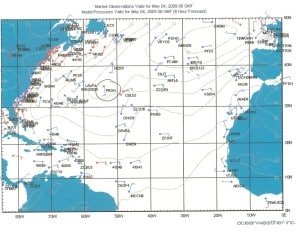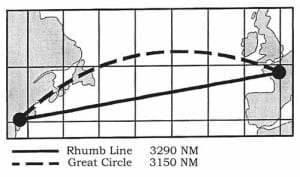 Captain Albert Schoonderbeek
Captain Albert Schoonderbeek
We were blessed with yet another day of good weather. Due to the new wave field coming in from the North the ship was moving a little bit more compared to yesterday but it is still a very smooth crossing. Also the light Northerly Breeze brings cooler air to the ship and thus the temperatures are about a degree less at noon time than they were yesterday. All and all it is fabulous weather for a spring crossing.
Today we also celebrated the middle of our crossing (more or less….. so it fitted in the entertainment schedule) and our cruise director marked the occasion by organizing a North Atlantic swim in the aft pool. This was a well attended affair and enjoyed to general acclaim; especially when the Cruise Director, startled by the ships whistle, fell fully clothed into the pool.
For the navigators a crossing is a peaceful affair with ships being far and wide in between. Yesterday we only sighted one bulk carrier but that ship came fairly close to us. So even on a crossing with hardly any traffic there is no room for complacency as one ship out there is enough to collide with.
One of the chores of the navigator on duty is to send a weather report ashore every six hours. There are now weather satellites that are so sensitive that they can measure everything from a great distance and with the internet the results are instantly accessible. There are weather sites you can log on to and see real time cloud formations moving over the globe. Huge computers are used to refine the prediction models upon which the Meteorologists base their next weather forecast and the predictions get more and more accurate all the time. However as we all know; the weather forecast is not always right and sometimes even completely wrong. It would not be the first time that we have been forecast partly cloudy skies and the next morning you can scoop 6 inches of that “partly cloudy sky” from your front porch.
Thus the meteorologists are very keen to get constant input from local observations. On land this is done by official agencies such as Airports and Coast guards but also by regular people. I know of one gentleman in my home county in England who has been doing this for 40 years without missing a single day. At sea it is done by the ships that participate in the program. This can be done in conjunction with the national weather service, which for the Dutch is the KNMI, or with the American side which is called the VOS project. (Vessel Observation) All Holland America ships are part of the VOS system as we mainly sail off the USA coast with only a few ships away for the summer in Europe.
And so every six hours, the navigator on duty or his assistant fills out a standard number of observations. Wind, waves, height, temperatures, etc.etc. If there is anything special observed, like water spouts etc. that can be added as well. The end report, we call this an OBS (coming from the word observation), is sent by email or satellite radio to a shore station. All the receiving shore stations are linked and the observations from all those ships that participate are shared. The observations are plotted in a chart and also become part of the enormous databank that is being used to create weather models for predicting the weather.

The circled position indicates where the Prinsendam sent in an OBS during May 04, 0600 GMT.
The nice thing is that we can see on the internet each day the result of our own observations, as they are plotted in a chart that is accessible in the public domain. Thus we can use our own observation together with those of all the other ships to get a picture of the actual weather around us. The observation of the Prinsendam is plotted in the chart shown above and we can recognize it as the ships call sign PBGH is printed next to it. As each ship has a unique call sign, it is easy to see how many ships have been sending in their OBS.
(Each country or flag state has an allocated number of call signs for their ships and the Dutch ones all start with a P. That P comes from the word Pays-Bays. Or Low Lands, the name Netherlands in the French language)
Tomorrow we have should have another peaceful day at sea.

